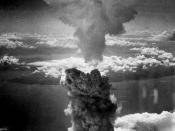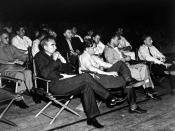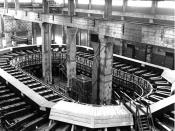In 1939 it was realized that atoms could be split. By splitting a uranium atom in half, both halves of the atom would have a positive charge and would repel each other with powerful force.
The German government took little notice of the finding at first. But others felt the implications were immediately clear. Niels Bohr brought news of Meitner's discovery to the United States in 1939. Several scientists, realizing that fission could be used to build a devastating weapon, wrote to President Roosevelt to inform him. He immediately set up a committee to research the matter.
By the end of 1941, British studies had outlined the materials requirements for an atomic bomb and uranium research was going on at about 12 American universities. During 1942, the Manhattan District of the Corps of Engineers was formed to construct three secret "cities" for major portions of atomic bomb development. At Oak Ridge, Tennessee, Hanford, Washington, and Los Alamos, New Mexico.
The cost of these Manhattan Project installations was $2 billion.
The first atomic bomb is detonated
1945
Photo: Atomic bomb test explosion in Alamagordo, New Mexico, July 16, 1945. AP/Wide World Photos
In 1932, James Chadwick discovered the neutron , a small atomic particle with mass but no charge. This turned out to be an extremely useful tool for bombarding atomic nuclei. Two years later, Enrico Fermi bombarded uranium with neutrons, hoping that it would cause the uranium to emit a beta particle and become a new, artificial element above uranium in the periodic table. It seemed he had done this and in the process showed that slow-moving neutrons were more effective than high-energy neutrons for the task. Fermi won the Nobel Prize for his work in 1938. He was a committed antifascist and when he and his wife...


